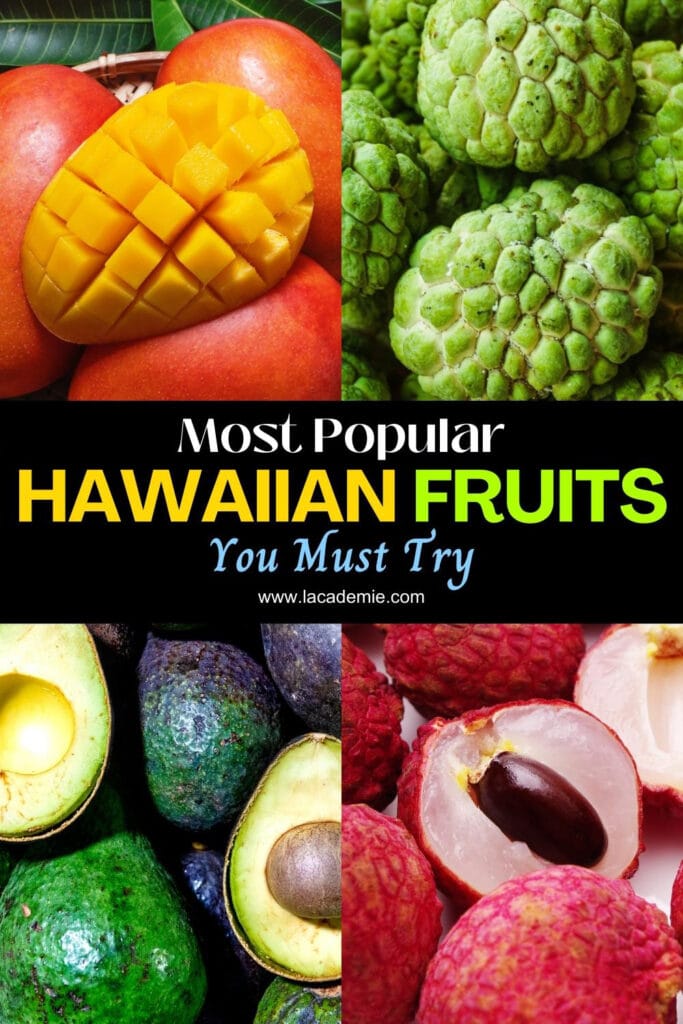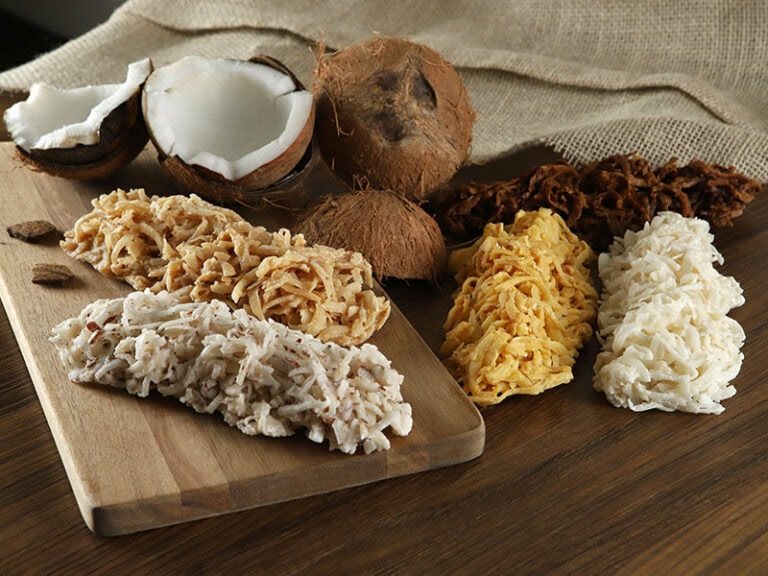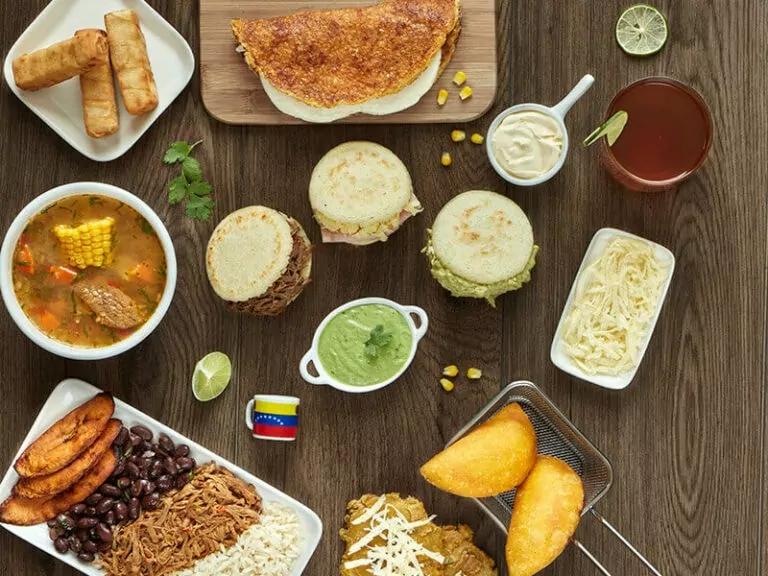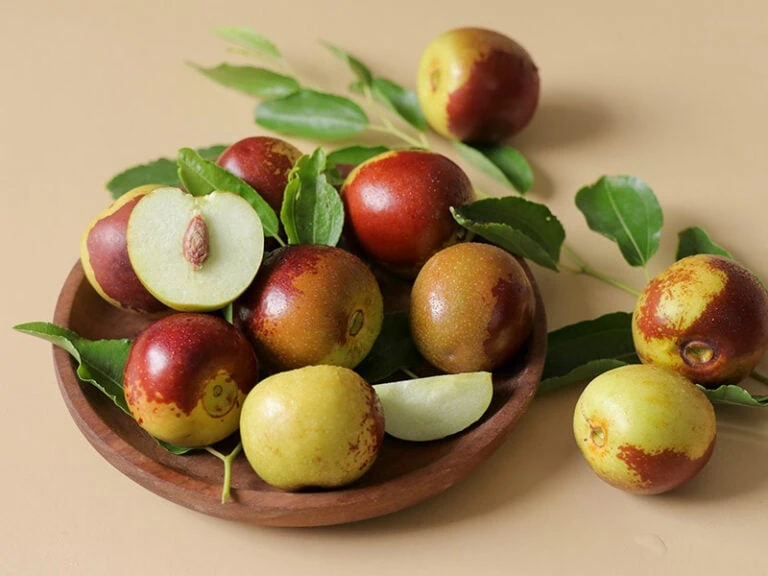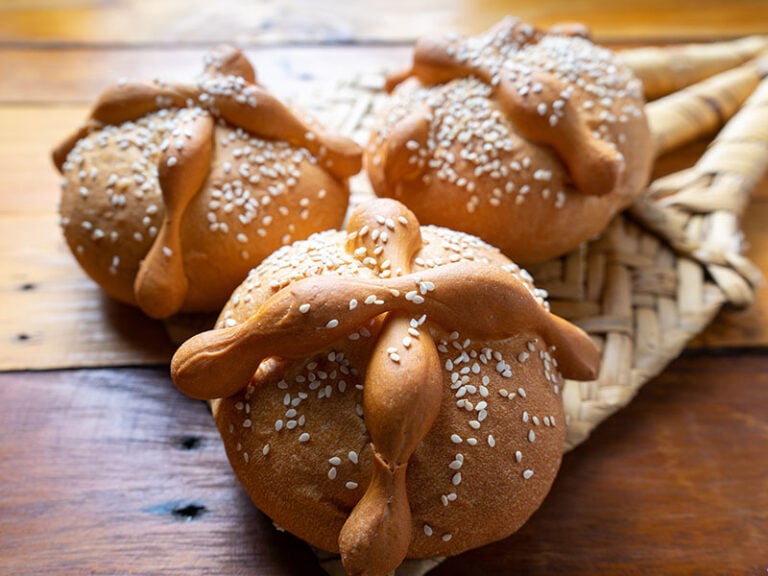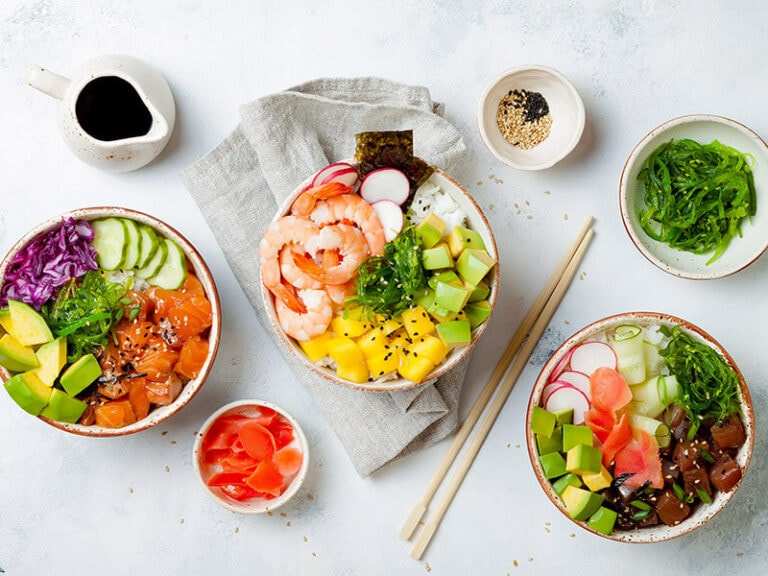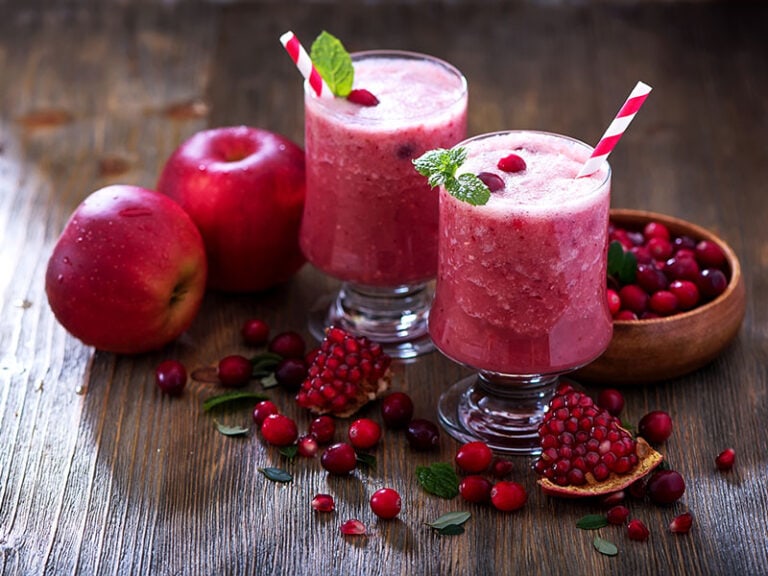Finding out the excellent Hawaiian fruits for dessert is not complicated, and it becomes more accessible with this article. I guarantee that their flavor will not let you down, so let’s bring the fresh breeze to your family’s meals.
In fact, some suggestions here are easy to find in your area, but some might not. Therefore, if you have a chance to visit this gorgeous island, do not miss out on the opportunity to try them.
Wait no more! Please step into the paradise of refreshing and mesmerizing fruits in Hawaii that you will love.
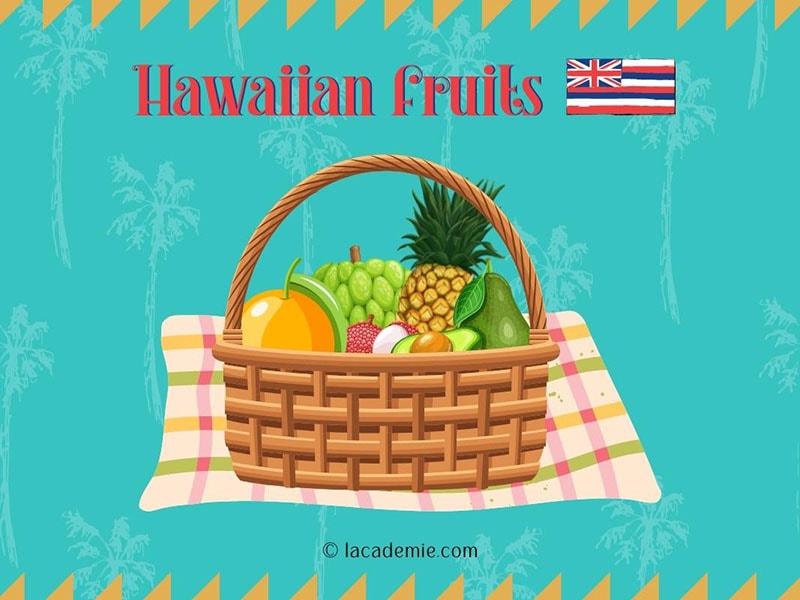
Excellent Hawaiian Fruits That Contain One Seed
There are many excellent different kinds of fruit over the world, and Hawai is no exception.When it comes to fruit with one seed, you will have many tasty options to experience when in Hawaii. The excellent taste will make you want to consume them again and again.
1. Mango
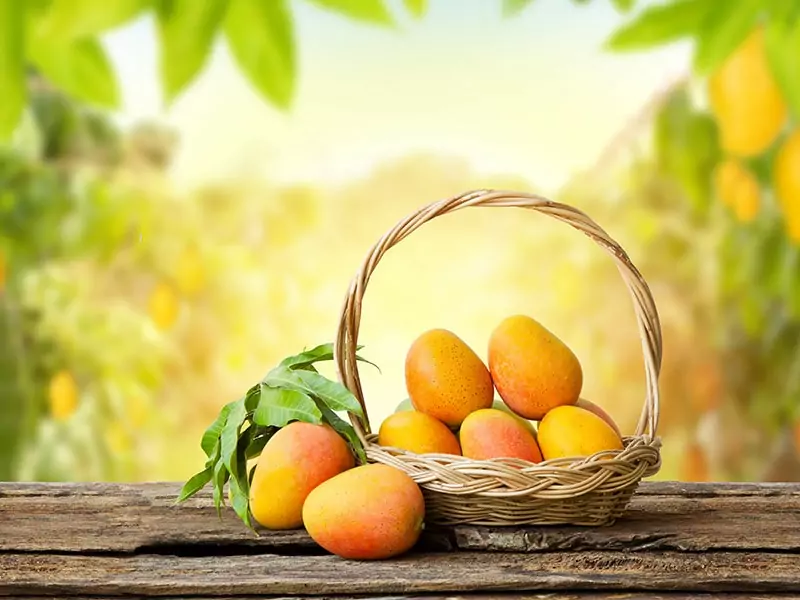
Mango is a famous fruit that belongs to the stone category since it contains an inedible seed in the middle. This juicy fruit’s origin is believed to be from Myanmar, India, and Bangladesh. In Hawaii, its cultivation started in 1824.
You can find about a hundred kinds of mango worldwide in various shapes, sizes, and colors. In Hawaii, there are about 60 types of mango that have been explored. Typically, most mangos have green, orange, gold, or yellow flesh.
In terms of shape, you can realize this fruit simply thanks to the distinctive oval, round, or kidney shapes. When touching it, the leather-like and smooth skin leaves a profound impression on your mind.
You’ll immerse yourself in the enchanting sweetness of ripe mangos. Plus, you can feel a slightly tart taste from this fruit. Enjoying the crisp unripe mangos is also a good choice. Dip them in chili salt, unripe mangoes can be your new favorite dessert to enjoy after meals.
Season: Its peak season ranges from June to July in Hawaii.
Nutrients: It is a source of carbs, protein, calories, fiber, and vitamin C.
How to eat: Peel its skin and eat the flesh around the pit. Another way is to cut the fruit around the seed and eat the meat from the peel.
Here is some important information about Hawaiian mango, especially the Makaha variety.
2. Lychee
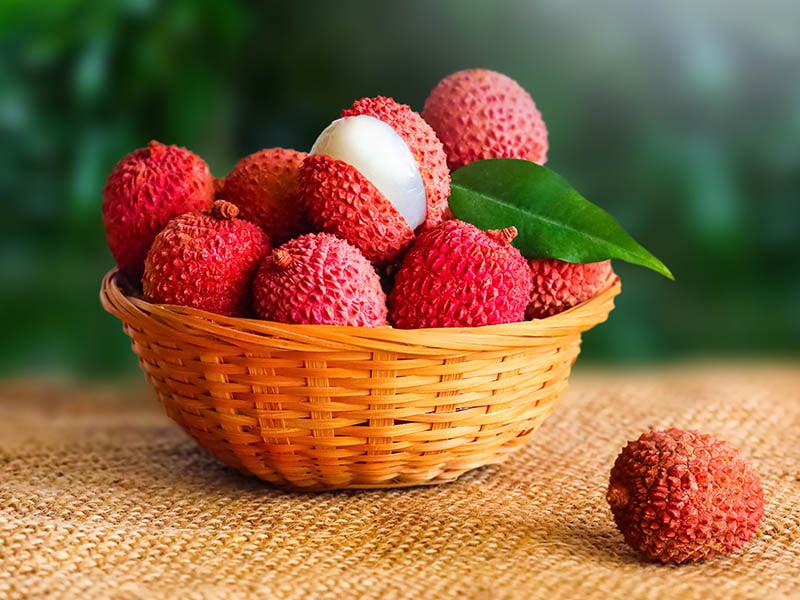
It is time to talk about sweet and delicious lychee. Lychee is an iconic member of the Sapindaceae family. This tropical fruit originates in China’s Fujian, Guangdong, and Yunnan provinces. And this country is the primary producer of lychee worldwide.
This excellent fruit has an eye-catching pink-red hue. Also, it is easy to feel the rough surface of its skin when you hold it. The sweet and edible flesh surrounds the inedible black seed. This fruit helps boost the vitamin B and C in your body.
In addition, I love the fragrance and charming sweetness of lychee in many delectable desserts, such as ice cream, cake, or cocktails.
Season: From May to September in Hawaii.
Nutrients: Rich in calories, protein, fiber, vitamin B, C, and carbs.
How to eat: Remove the peel and consume the off-white flesh (remember to get rid of the black seed).
3. Longan
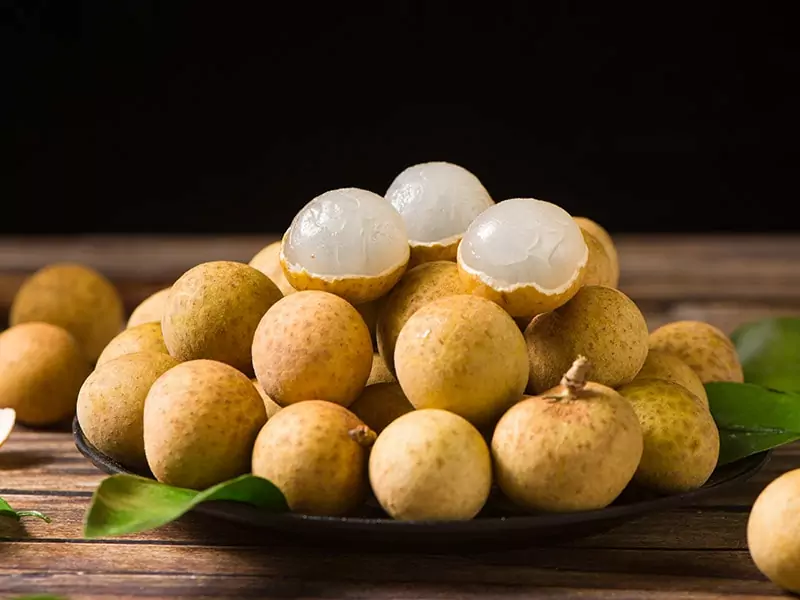
Another tropical fruit I want to introduce in this post is longan. It belongs to the same family as the rambutan and lychee. Therefore, you can find many similarities between them. It has 3 main parts like lychee, including thin skin, sweet flesh, and a round seed inside.
This yummy fruit was born in China and other regions of Asia. Sometimes, people call it “dragon’s eye” because you can think of a giant eye when you glance at this fruit. It looks dominant in the tan and leathery peel.
People love to consume juicy and sweet flesh as a dessert. Furthermore, you can feel a bit of musky undertone from longan. You can eat it raw or add it to soups, desserts, and snacks. Moreover, it is perfect to dry longan and they are an excellent addition in sweet soups.
Season: Longan is available all year round on this island.
Nutrient: High in fiber, calcium, zinc, phosphorus, vitamin C, and B2.
How to eat: Crack its skin with your hand and remove it. Then, eat the flesh around the black seed.
4. Rambutan
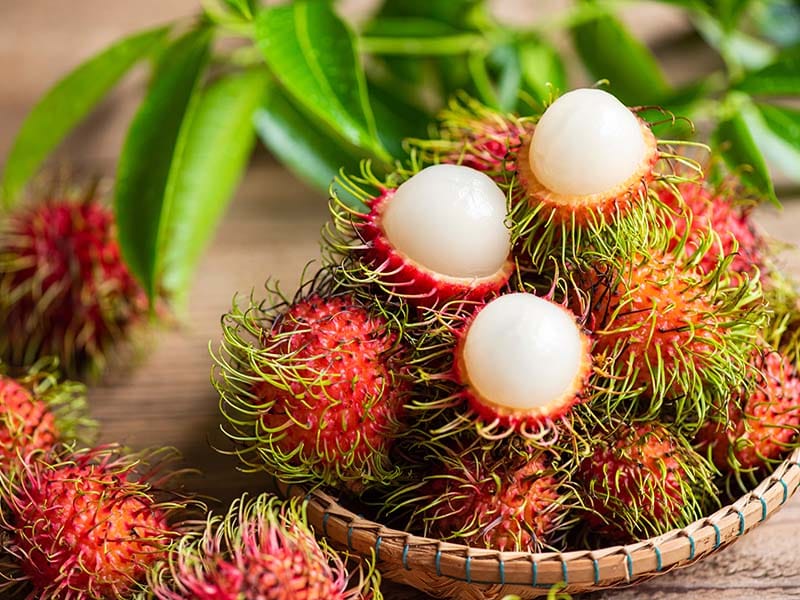
You’ll quickly see rambutan sold in many local markets in Southeast Asia. What’s more, you can come across this fruit in Hawaii too! Its name is derived from the word “rambut”, which means “hair” in Malay, and this has to do with its appearance.
Its shell has many tiny and soft hairs that make it look like a head with many hairs. After peeling off the leathery skin, you can eat the whitish or pale pink flesh. You’ll go crazy with the sweetness and mild sourness of this fruit.
Thailand is a leader in rambutan production worldwide. Until now, people have discovered about 200 different kinds of rambutan globally. And the warm tropical climate is an excellent condition for the growth of this fruit.
Season: Its season extends from February to March.
Nutrients: Less in fat, high in vitamin C, fiber, and other nutrients.
How to eat: Peel the skin before consuming the flesh.
Let’s learn how to eat rambutan properly.
5. Avocado
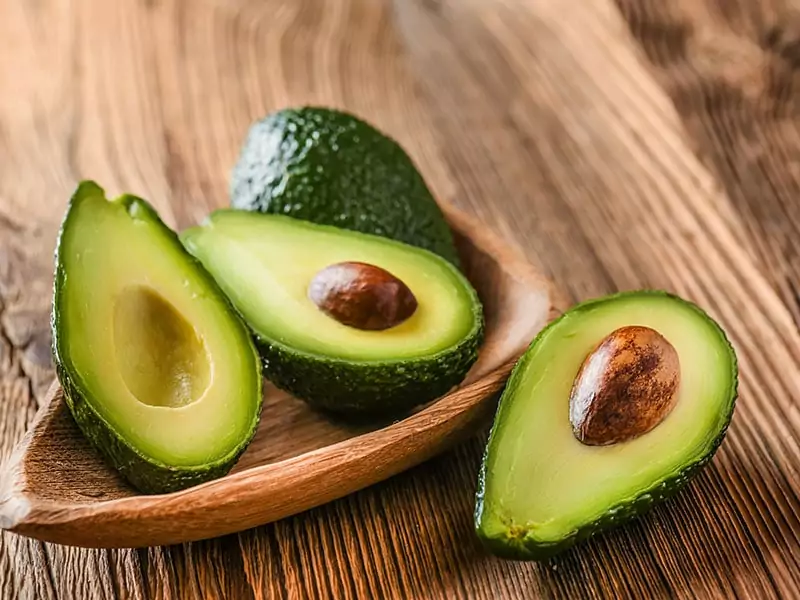
Avocado is a healthy and versatile fruit you must try in Hawaii. This land is a paradise of avocado, with about 200 varieties of avocado. So, it is easy to spot avocados in the Haiwaian households’ backyard.
The smooth and buttery texture of avocado is ideal for making fresh salads and sandwiches. In addition, it is hard to resist the fantastic taste of avocado smoothie. Sometimes, people mash this fruit to replace mayonnaise.
In fact, Mexico and Guatemala are the true birthplaces of this excellent fruit. Its shade is diverse with green, brown, black, or purplish skin, depending on the different types. Regarding the health benefit, avocado is high in healthy fats, vitamins, and minerals.
Season: Its season runs from January to April in Hawaii.
Nutrients: Good source of healthy fats, fiber, vitamin E, C, B6, magnesium, and folate.
How to eat: Slice avocado into 2 sections, remove the seed and use a spoon to scoop the flesh to eat.
Fruits With Many Seeds You Can Find In Hawaii
Do not miss the chance to enjoy the fantastic flavor of these fruits in this section. They contain a lot of seeds, which can be either edible or inedible.
Amazing Fruits That Have Alluring Green Shade
If you are looking for delicious fruits with green color, you should follow this section to choose suitable and best-loved options when visiting Hawaii.
6. Breadfruit
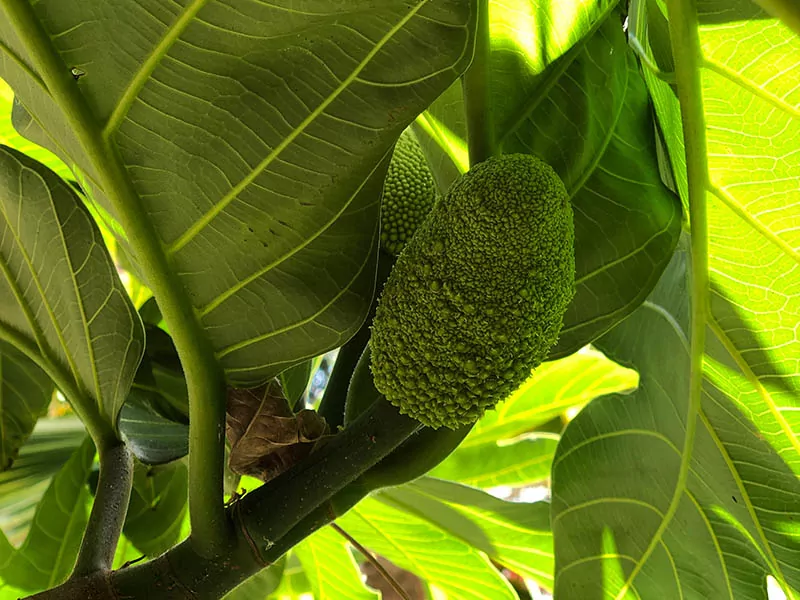
It is a shortcoming not to mention Breadfruit in Hawaii’s list of favorite fruits. On this island, it is called “Ulu”. This fruit originates in New Guinea and the Philippines. The ancient Polynesians introduced this fruit to Hawaii in 300 AD.
Although this one is not an authentic fruit of this land, it plays a crucial role in the life of Hawaiians. Since people love to consume this fruit to satisfy their hunger, this delicious fresh treat is a source of carbs and healthy vitamins.
Nowadays, you can find this fruit in many regions worldwide, such as Africa, the Caribbean, and Asia. Commonly, breadfruit has an oval shape and is separated into many achenes. You can find both seed and seedless species.
In many regions, people often consume breadfruit as a staple food. To enjoy the raw, unripe fruit, you must bake, boil, fry, or roast them. If breadfruit is ripe, please feel free to enjoy them fresh as a dessert or mix them in many delicious dishes.
Season: It is common in Hawaii in the summer months.
Nutrient: High in fiber, protein, potassium, phosphorus, niacin, and thiamine.
How to eat: Slice the fruit into 2 sections and consume its flesh.
Discover all things about the importance of breadfruit in Hawaii.
7. Soursop
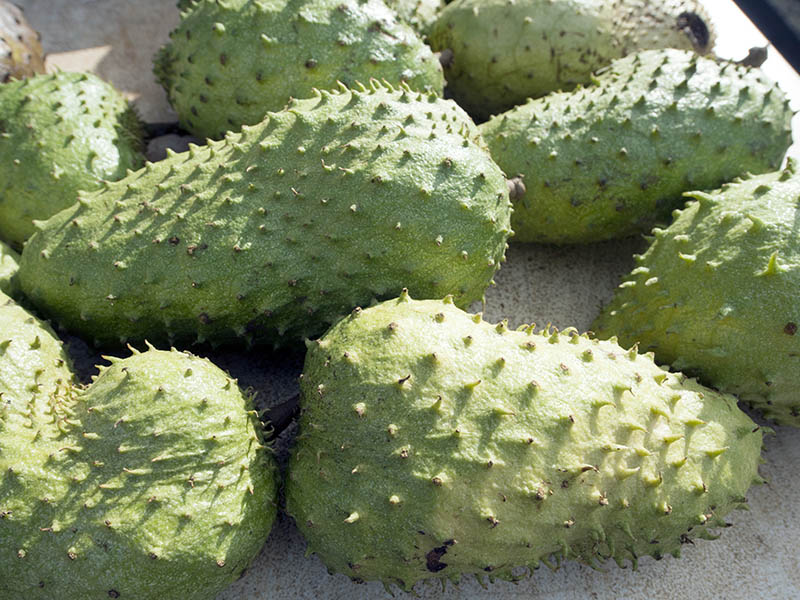
It is hard to forget the distinctive sour-sweet taste of this delectable fruit. Soursop is a native fruit of the Americas and the Caribbean. This yummy fruit belongs to the Annonaceae family and grows well in tropical climates.
Its intense aroma will stimulate your sense of smell immediately. This appealing fragrance is pretty similar to pineapple. Its taste is similar to the blend of apple, strawberries, and sour citrus fruits.
Furthermore, its creamy texture is an excellent option to add to ice cream, smoothies, or other desserts.
In terms of appearance, soursop looks rustic in the dark green and prickly skin. This oval fruit has a reasonably firm texture. By consuming them properly, you can improve your health because it contains many vitamin C and healthy minerals.
Season: It is common in Hawaii from January to April, June to August, and October to November.
Nutrients: A source of calories, protein, carbs, fiber, and vitamin C.
How to eat: Cut this fruit into smaller parts and scoop the flesh to eat. Do forget to discard the seeds while eating.
8. Cherimoya
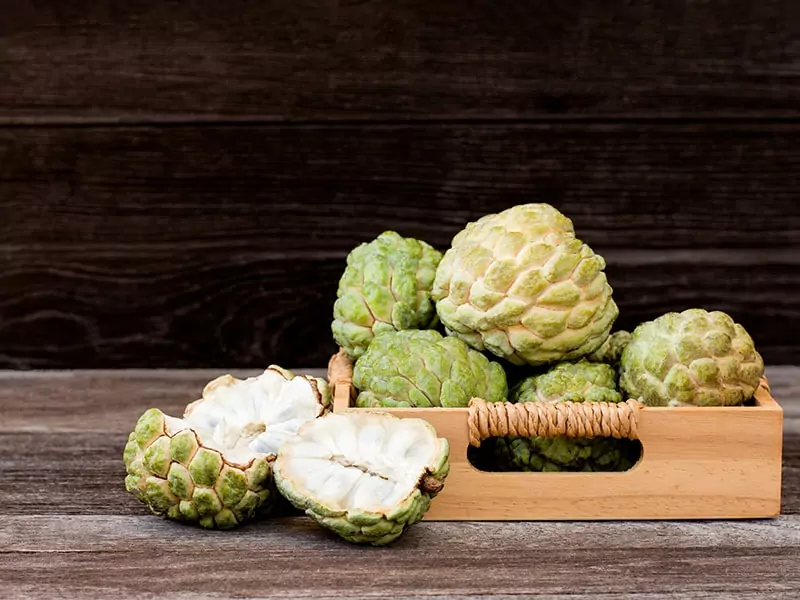
Cherimoya belongs to the Annonaceae family. This fantastic fruit has its origin in Ecuador and Peru. Also, its cultivation is common in Central America, Andes, tropical, and subtropical regions.
Its name comes from the word “chirimuya meaning “cold seeds”. This fruit is also known as “chirimoya” in South American countries. Regarding its appearance, cherimoya has a typical heart shape with overlapping scales on the skin’s surface.
After removing the peel, you can eat this fruit’s creamy and yummy flesh. To enjoy the authentic flavor, you should consume fresh cherimoya. Also, you can add it to desserts to enhance their taste.
Season: Available all year round.
Nutrients: A source of calories, vitamin C, phosphorus, potassium, and magnesium.
How to eat: You have to cut it into 2 halves, get rid of the seeds, and scoop the flesh with a spoon to eat.
9. Cacao
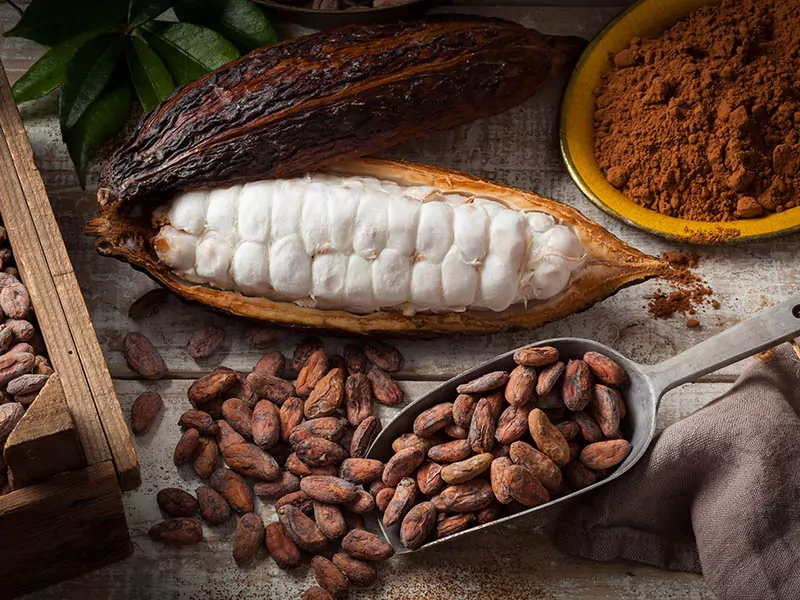
Cacao plays an essential role in many delicious dishes. People often use its seeds to make cocoa solids, chocolate, chocolate liquor, and cocoa butter. Ivory Coast is the leading producer of cocoa worldwide.
After removing the thick skin, you’ll see its fresh pulp immediately. This fruit’s creamy flesh tastes slightly citrusy. Therefore, when enjoying its pulp, you can think of the flavor of mango or lychee.
You can turn the fruit into cacao powder as well. This ingredient is helpful for blood pressure. In addition, using cacao helps boost the health of the brain and heart. Even better, cacao is a good choice for preventing the risks of diabetes.
Season: The season is relatively higher after the rainy season.
Nutrients: Rich in calories, protein, carbs, fiber, and flavonoids.
How to eat: Crack the pod and eat the pulp from the seeds. Or use cacao beans to make chocolate.
Learn the vision of cacao in Hawaii with this introduction right now.
10. Jackfruit
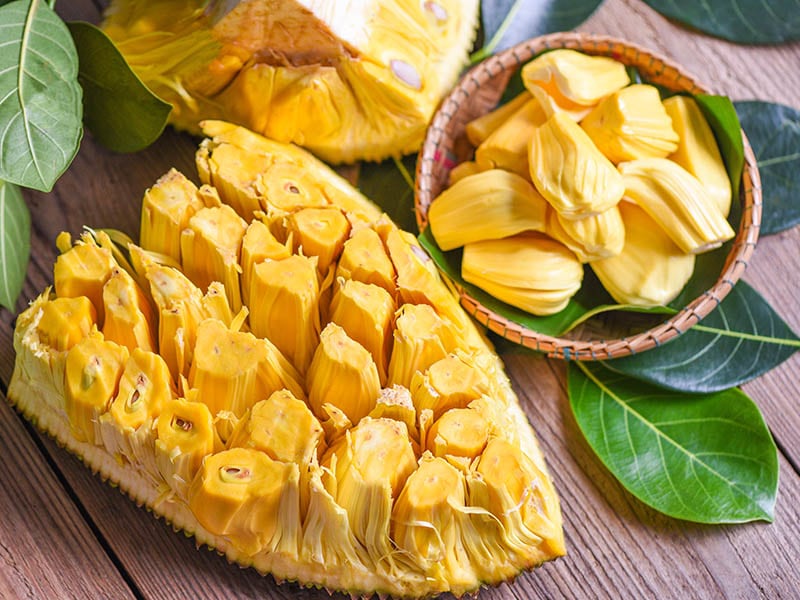
I love the sweetness and charming aroma of jackfruit, so I always taste this fruit when I come to Hawaii. This excellent fruit derives from southern India, Sri Lanka, Bangladesh, and other Southeast Asian countries.
Garcia de Orta was the first to use the name “jackfruit” in his book in 1563. Typically, a jackfruit tree can create about 200 fruits in a year. You should be careful when touching the jackfruit since it has a thick crust with many tiny spikes.
Inside, it has numerous small and yellow segments. Each segment will contain a big pit. And they will attach to a whitish core. If you want to consume the seeds, you should steam, roast, or boil them and enjoy them as a snack.
Season: Its season runs from August to December in Hawaii.
Nutrients: Rich in calories, carbs, fiber, vitamin A, C, magnesium, and riboflavin.
How to eat: Slice the fruit into 2 parts, remove the white core and get the segments with your hand. Consume the flesh and throw away their seeds.
11. Noni
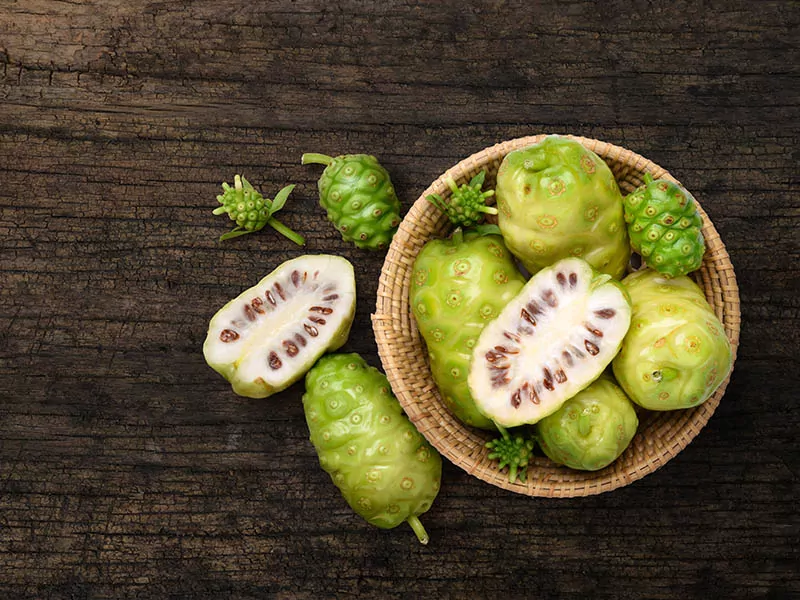
Noni is an excellent fruit you have to give a shot when coming to this island. It has its origin in Southeast Asia and Australia. It is also known as Indian mulberry, and the early Hawaiians introduced this fruit to this island a long time ago.
It is hard to confuse it with any other fruits because it has an intense and vomit-like odor. However, it is considered an essential food in many places. Furthermore, noni is a beneficial ingredient in making traditional medicine.
When ripe, its skin will turn from yellow to white. In addition, you can find many seeds in this fruit. If you are a fan of tart and bitter fruit, it is a suitable choice for you. Even better, you get a fishy aftertaste while tasting this fantastic fruit.
Apart from using noni in culinary, it is helpful in making lotions, soaps, or beverages. Occasionally, people use it as a dyed product. A feature that makes me love this fruit is that I can enjoy the seeds after roasting them.
Season: You can find them all year round.
Nutrients: Rich in vitamin A, C, calories, and other nutrients.
How to eat: Use a knife to remove the skin, then slice it into 2 halves and eat the flesh. Remember to get rid of its seeds.
Go into a noni garden in Hawaii to discover new things about this fruit.
Save These Hawaiian Fruits With Yellow Color Right Now!
These yummy fruits that have bright yellow color will grab your attention in no time. Let’s read this part to understand more about them right now.
12. Papaya
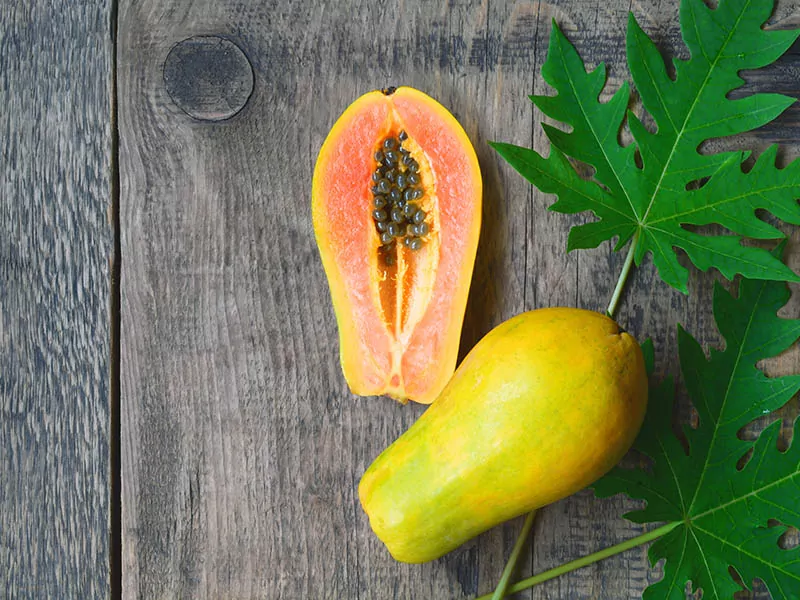
If you are looking for a sweet fruit for dessert or making flavorful recipes, you should not miss papaya. Mexico and Central America are the homelands of this beautiful fruit. It appeared in Hawaii over a century ago.
You can quickly come across this excellent fruit on the Big Island of Hawaii.There are many various types of papaya as well.
Papaya is a berry that has a similar shape to a pear. When ripe, this fruit has soft flesh with red or yellow shades. The skin of the unripe version is green, and you will love the crunchy flesh of this choice.
Moreover, it is essential to remove the countless black seeds in the center of the fruit. When tasting papaya, its sweetness captivates you in no time. This taste can make you think of the flavor of mango and cantaloupe melons.
Season: It is available all year round in Hawaii.
Nutrients: Plenty of folates, vitamin A, copper, fiber, magnesium, and potassium.
How to eat: Discard the skin with a knife, remove its seeds and eat the juicy flesh.
Take a closer look at Hawaiian papaya by getting into a papaya farm.
13. Loquat
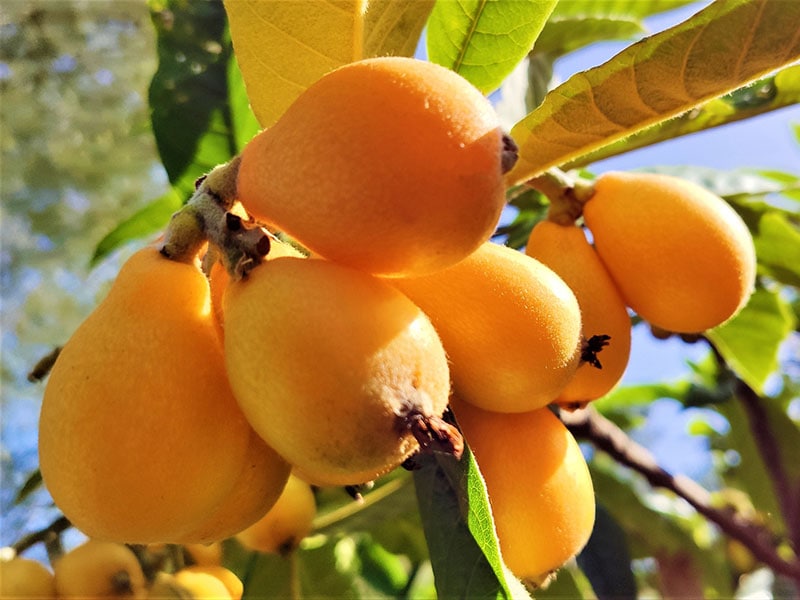
Loquat is a local fruit of the hill regions in China. People know it as “Biwa” or “Nispero” in Japan and other areas. It is a long-standing fruit that has been cultivated for a few centuries. The Chinese immigrants introduced this fantastic fruit to Hawaii.
This fruit develops in the clusters, and you often see it in oval or pear-like shapes. Its skin shade varies from yellow, red, or orange. You get a pleasant feeling when touching the silky and downy skin of loquat.
The white flesh gives a dominant tangy flavor, while the orange or yellow versions taste sweeter. This fruit is common in Asia, with more than 800 different loquat varieties.
Aside from consuming fresh ones, adding this fruit to fruit salads or fruit cups is acceptable. Furthermore, you can turn this fruit into delicious jam, jelly, or chutney. It is also suitable for making smoothies and juice for dessert.
Season: The season runs from September to April in Hawaii.
Nutrients: It is rich in antioxidants, vitamin C, and potassium.
How to eat: Let’s peel the skin before eating the flesh.
14. Egg Fruit
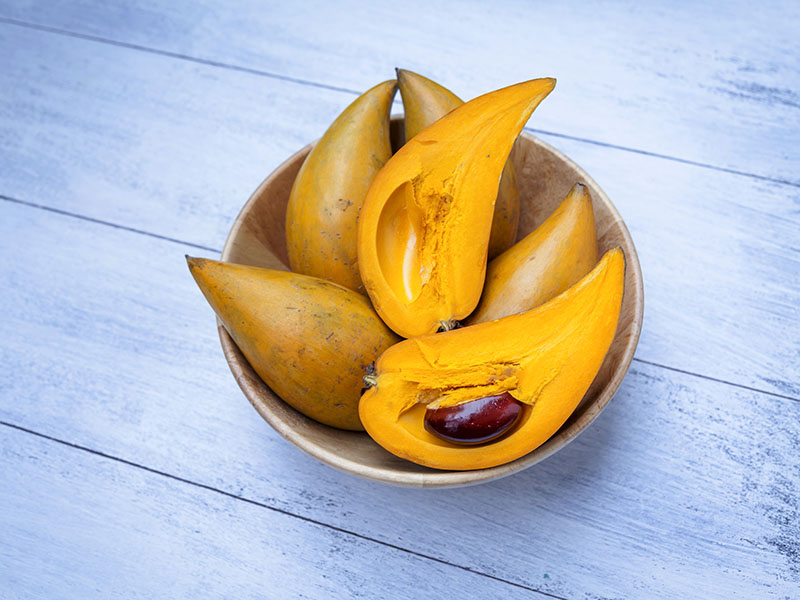
In Hawaii, egg fruit holds a strong place in the hearts of natives and tourists. This fantastic fruit was first found in Mexico and gradually became popular in Central and South America, the Caribbean, and Asia.
When you look at it, you can imagine the shape and texture of a hard-boiled egg yolk. The bright yellow shade is an impressive highlight of this yummy fruit. It tastes similar to the sweet potatoes with a dry sweet flesh.
Typical egg fruit contains about 2 to 4 brown seeds, but you can also find some with only 1 seed. And they are inedible. For culinary, you can use it to make jams, pancakes, ice cream, or marmalade. Besides, it is acceptable to eat raw egg fruit, as long as they are ripe.
Season: The season extends from October to February in Hawaii.
Nutrients: It contains vitamin C, A, potassium, carbs, and magnesium.
How to eat: Cut the fruit, remove the seeds, and eat the flesh from the skin.
15. Golden Berry
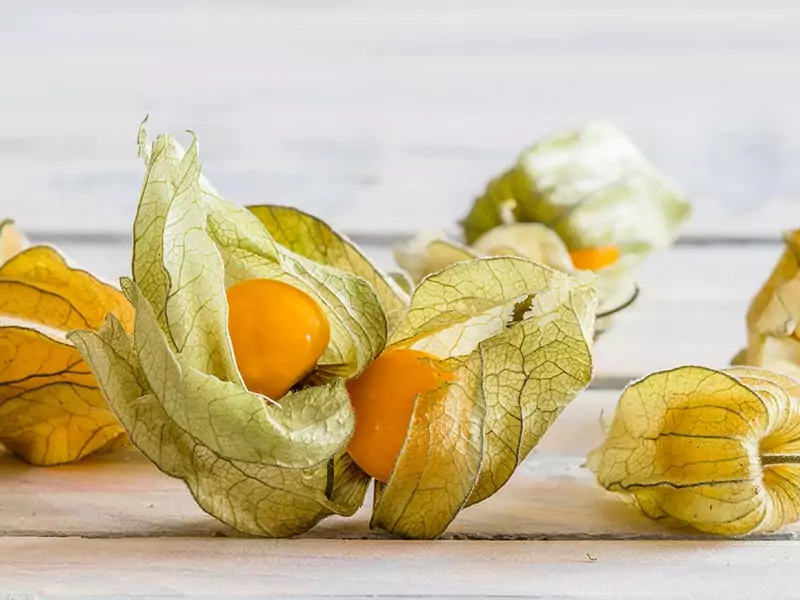
Golden berry belongs to the Solanaceae family. It is called uvilla, uchuva, or aguaymanto in many regions. And Hawaiians call it “Poha berries”. This beautiful berry originates in Peru, Ecuador, and Colombia.
The cultivation appeared for the first in the Inca Empire. And it appeared in England in the late 18th century. Then, it became global in the 20th century. Nowadays, buying this fruit in many tropical or subtropical places is not too complicated.
It has a perfect round shape with smooth skin. It looks like a miniature yellow tomato. You can recognize this fruit thanks to its bright yellow or orange colors. The sweet and slightly tart taste will tickle your taste buds instantly.
This healthy and nutritious fruit is a compatible ingredient in culinary. You can blend it in many sauces, puddings, jams, pies, or other incredible desserts. Nutritionwise, it is full of vitamin C, thiamin, and niacin.
Season: All year round.
Nutrients: Rich in vitamin K, C, iron, potassium, and phosphorus.
How to eat: Rinse it with clean water before consuming the fruit. Do not forget to throw its seeds.
16. Starfruit
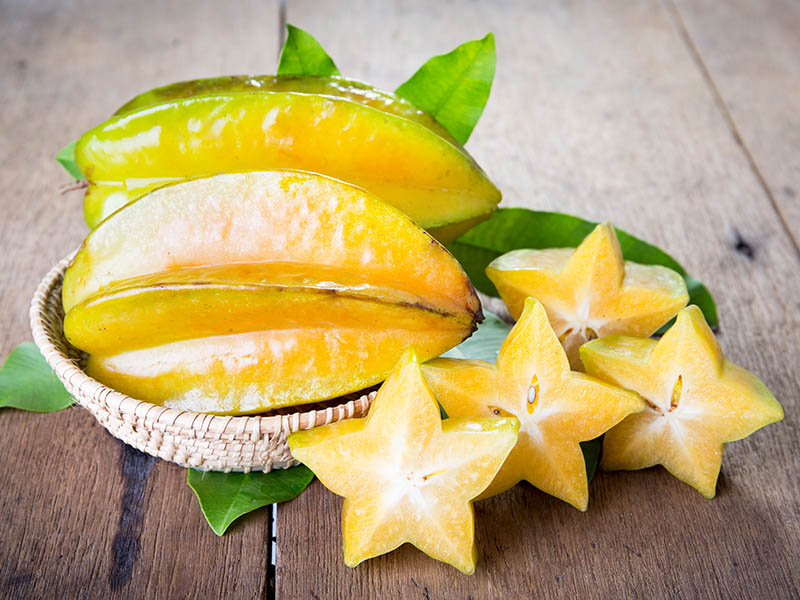
Starfruit or carambola is a well-known fruit originating in Southeast Asia. Moreover, tropical areas are suitable for the cultivation and development of starfruit. It has many different names, such as “khế”, “belimbing”, or “mafen” depending on various regions.
It is simple to identify starfruit because this fruit has a striking yellow or green skin. And you can eat its skin without worry. In addition, 5 or 6 ridges running around it make it easier to recognize this fruit.
When you cut this fruit horizontally, it’ll have star-like slices. Starfruit contains a lot of antioxidants, vitamin C, and fiber. They have a practical effect in controlling blood sugar, improving the immune system, and protecting cardiovascular health.
Season: Its season extends from September to April in Hawaii.
Nutrients: High in fiber, vitamin C, calcium, and potassium.
How to eat: It is acceptable to consume the whole fruit after rinsing it with clean water.
Fall In Love With The Famous Hawaiian Red Fruits
The amazing flavor of Hawaiian fruits that are red will captivate you at the first try. So, please save these suggestions in this section for your upcoming trip.
17. Hawaiian Mountain Apple
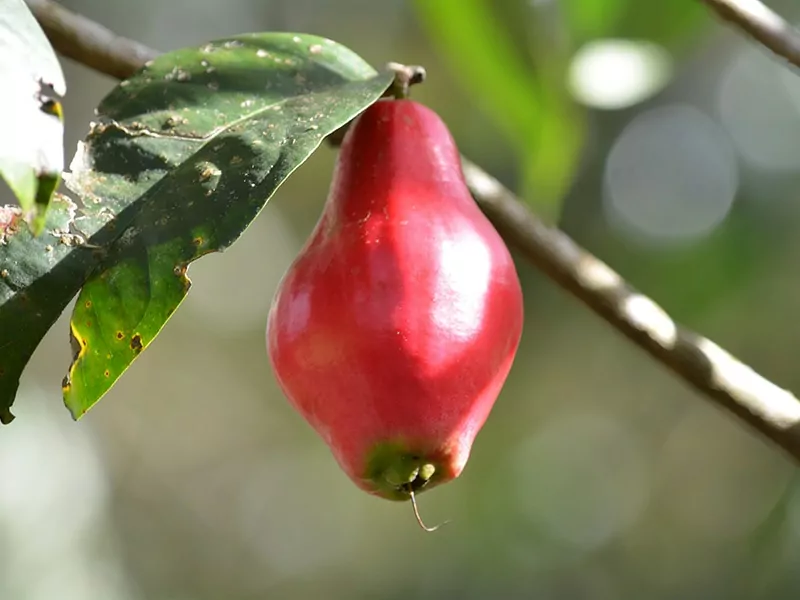
Mountain apples are the best-loved fruit of the Hawaiians. Polynesian settlers brought this fruit to Hawaii from Malaysia. Its shape is quite similar to a pear or heart, and it is covered with shiny, waxy skin.
The color of this fruit is pretty eye-catching with light pink and ruby red. I believe you’ll love this excellent fruit’s light, crunchy texture. The cream-colored flesh of this apple has a mild sweetness and a tantalizing rose-like aroma.
It has some hard seeds in the center of the fruit. Indeed, these seeds look like date pits. You can go to the farmer’s markets, roadside, or farm stands to buy this fruit when you visit Hawaii. And it is common in Hawaii from summer to autumn.
Season: It is common in Hawaii from late summer to autumn.
Nutrients: It is rich in calories, fiber, sodium, potassium, and vitamin A.
How to eat: Discard its skin and cut it into small pieces to eat.
18. Strawberry Guava
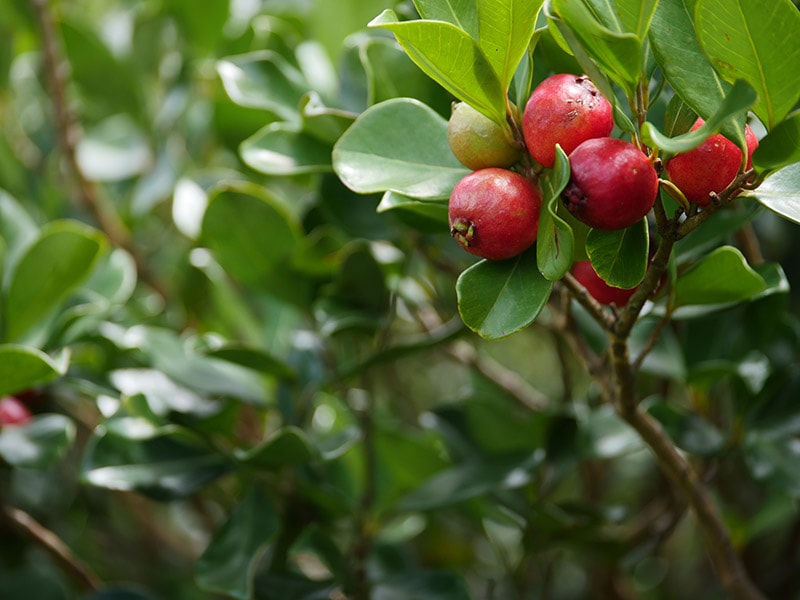
There are countless guava cultivars, but strawberry guava is the most common and unique species in Hawaii. This excellent fruit with S as the beginning letter is a feature of the Myrtaceae family. Aside from this name, you can know it as cherry guava or Cattley guava.
In Hawaii, natives often call it “waiawi”. It has many similarities to regular guava, but it looks extraordinary in the red skin. Flavorwise, it tastes tangy and mildly sweet, and you can think of the fresh strawberries while eating it.
This fantastic fruit is native to Brazil and was cultivated in Hawaii in early 1825. Nowadays, it is easy to buy this fantastic fruit in many agricultural markets on this island.
For culinary, locals love to use this fruit in making fresh and nutritious smoothies. Occasionally, you can feel its characteristic taste in salads or chicken dishes. Of course, there is no trouble eating the raw ones.
Season: You can find it commonly in Hawaii from August to December and January to April.
Nutrients: Plenty of calories, protein, carbs, fiber, and vitamin C.
How to eat: Remove the peel and consume its flesh and edible seeds.
19. Surinam Cherries
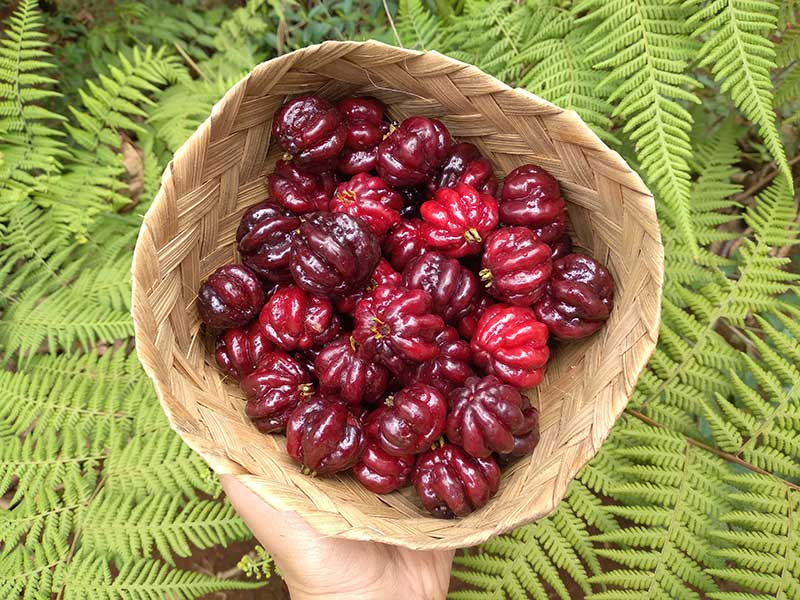
Surinam cherries or pumpkin cherries are one of the main options for natives. Its appearance is similar to a small red pumpkin. It is an exotic fruit in Hawaii since people plant this excellent fruit commonly in their backyard.
This yummy fruit has its origin in Suriname, Brazil, Argentina, and Paraguay, which belongs to the berry group. The sweet and sour taste of these cherries are mesmerizing. It is commonly used in making jellies and jams.
Also, you can take advantage of its leaves to make tea. Regarding the nutrition wise, this delicious fruit contains a lot of vitamin A and C.
Season: Its season lasts from March to May and September to November.
Nutrients: High in calories, carbs, vitamin C, A, B2, and magnesium.
How to eat: Wash and consume them (remember to remove their seeds).
20. Dragon Fruit
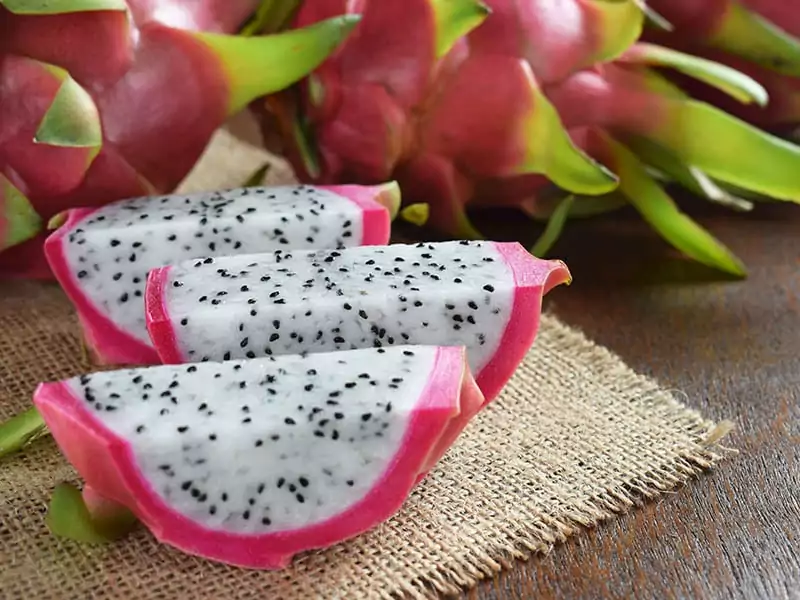
Dragon fruit or pitaya is a popular tropical fruit in Hawaii and many other world areas. This tasty fruit originates from South and Central America. Today, dragon fruit cultivation occurs widely in Southeast Asia, East Asia, Mexico, and the Caribbean.
It has had the English name “dragon fruit” since 1963. The leathery-like skin with many scaly spikes is the source of its name. Its peel makes it look like a dragon’s head. In some places, people often call it “strawberry pear”.
There are various kinds of dragon fruit, including pitaya Blanca, pitaya Amarilla, and pitaya Roja. You can distinguish them thanks to the difference in flesh and skin color. Typically, most dragon fruit types have red or white flesh and pink or yellow skin.
You’ll go crazy with the mild sweetness of dragon fruit. Its flavor reminds you of the combination of kiwi and pear. Instead of eating raw dragon fruit, you can add it to salads, smoothies, or other desserts.
Season: Its season lasts from late July to October in Hawaii.
Nutrients: Contain fiber, protein, vitamin C, calcium and more.
How to eat: To eat dragon fruit, you just need to slice it into small slices and consume the flesh and tiny seeds.
Check some information about dragon fruit in Hawaii immediately.
21. Sapote
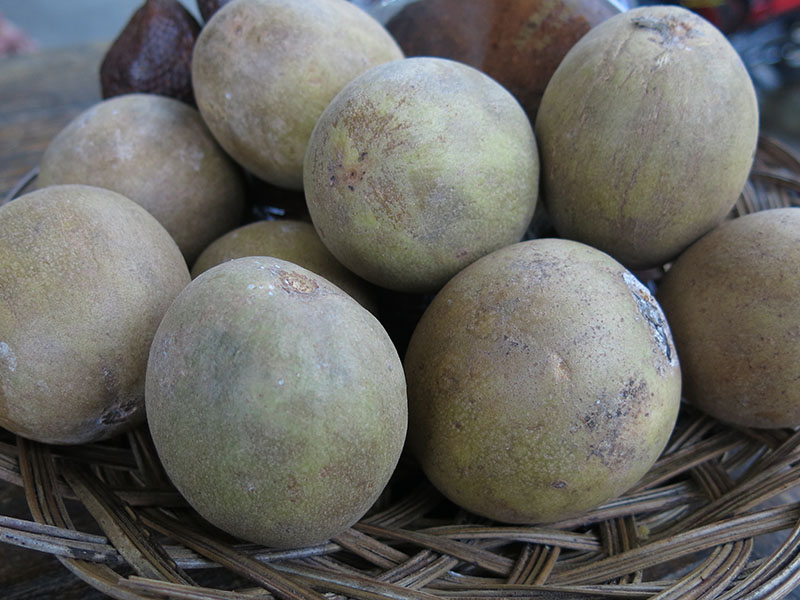
If you have a chance to visit Hawaii, you have to give sapote a try. This fantastic fruit originates in Central America, South America, and Mexico. Besides this name, you can call it “soapapple” in Caribbean English.
There are many types of sapote with various shades, including yellow sapote, sapodilla, green sapote, and mamey sapote. They not only differ in color and flavor but are also diverse in origin.
You’ll immerse yourself in the subtle sweetness and a nutty and pumpkin-like touch. Its smooth and soft texture is reminiscent of pudding when eating sapotes. On the other hand, it is a pity if you do not use sapote to make smoothies, ice cream, and preserves.
Season: Its season lasts from summer to December in Hawaii.
Nutrients: High in calories, protein, potassium, vitamin A, and C.
How to eat: Use a knife to cut it in half, remove the seeds and consume the flesh with a spoon.
Expand Your List With Seeded Fruits In Other Colors
Besides these above options, you can consult these other choices in this part to diversify your list. They can be black or purple, so let’s explore if you want recommendations for these shades.
22. Passion Fruit
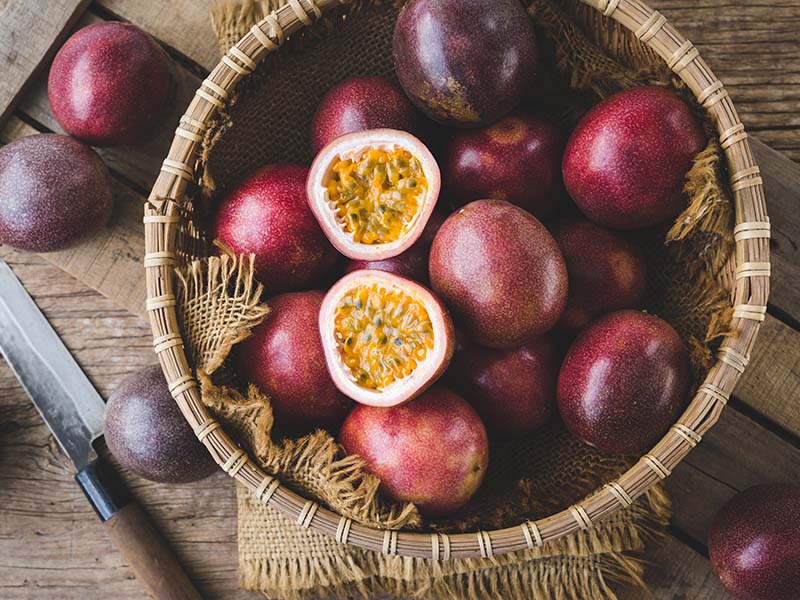
Passion fruit is a well-known fruit in many parts of the world. It is a member of the vine species. This excellent fruit comes from southern Brazil, Argentina, and Paraguay. Gradually, its popularity spreads to Hawaii and many regions.
Round and oval are the familiar shapes of this fruit. Its red, purple, green, or yellow skin can immediately catch your eyes. Its tart taste is suitable for making juice or adding salad dressing or other dishes. And there is no problem with consuming its seeds.
It is simple to see many notable species of passion fruit, and it has 4 main types, including yellow, purple ones, giant granadilla, and sweet granadilla. If you would like to supplement niacin, ion, vitamin C, or carbs, it is an ideal choice.
Season: Its season lasts from June to January.
Nutrients: Rich in calories, fiber, vitamin A, C, iron, and potassium.
How to eat: Dice it into 2 parts and get the flesh and seeds with a spoon.
23. Mangosteen
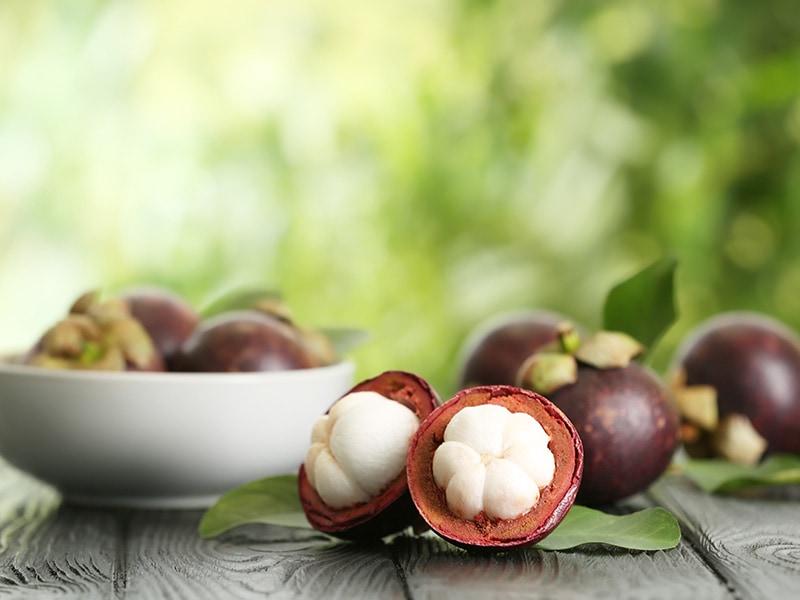
It will be a huge mistake if you miss mangosteen in Hawaii. Although it comes from Asia, you can buy this fruit easily on this island. In Southeast Asian countries, people consider it the “Queen of Fruit”.
The succulent fruit contains about 6 to 10 white segments beneath the thick purple skin. You will love this famous fruit’s enchanting sweetness and tangy flavor. Do not forget to get rid of the seeds while eating them.
Thailand is the primary maker of mangosteen globally. Mangosteen has many practical uses in culinary, medicine, and others. People often eat raw mangosteen as a fresh dessert. In addition, it is a natural dye for coloring purple or red shades.
Season: Mainly available in the winter on the island.
Nutrients: High in sodium, carbs, fiber, vitamin C, and calories.
How to eat: Separate mangosteen into 2 halves and eat the flesh around the seed of each segment.
24. Jaboticaba
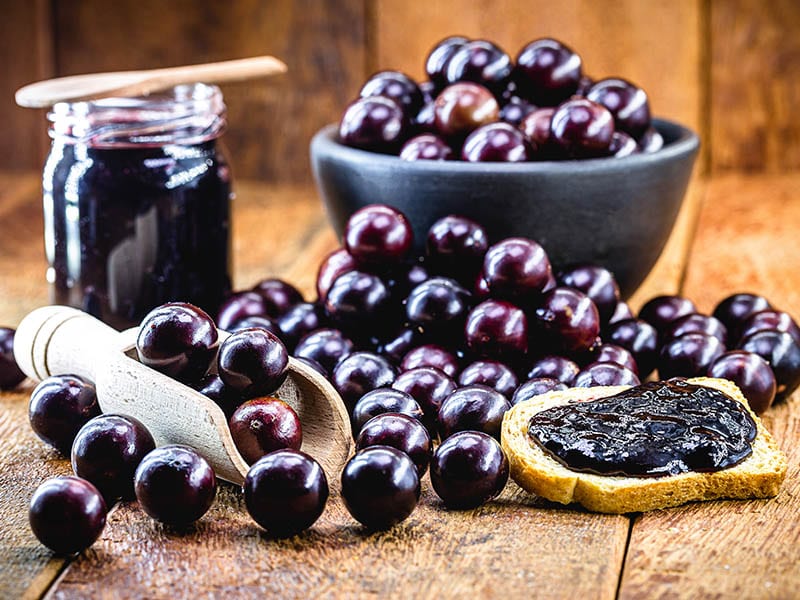
Although Jaboticaba is a native Brazilian fruit, it is also widely loved in Hawaii. In addition, you can eat it in Paraguay, Peru, Bolivia, and Argentina. It is a versatile fruit because you can eat it raw and make many different dishes with this ingredient.
It is a berry with dense and purple skin. When eating the flesh, you will be impressed by the charming sweetness of its pink or white flesh.
Its name is a combination of the word “jaboti” and “caba”, which means “tortoise” and “place”. In particular, it is not easy to buy this fruit at local markets because of its short shelf life. It is better to go to the farms or gardens to purchase it.
Season: Ripening season in the warm months.
Nutrients: High in protein, calcium, iron, vitamin C, B, and phosphorus.
How to eat: Use your fingers to squeeze the flesh out of the skin or you can bite the fruit to open.
Incredible Hawaiian Seedless Fruits For Your Dessert
Besides these seeded fruits in the above parts, you can refer to this section to explore the best seedless fruits for dessert after heavy meals in Hawaii.
25. Pineapple
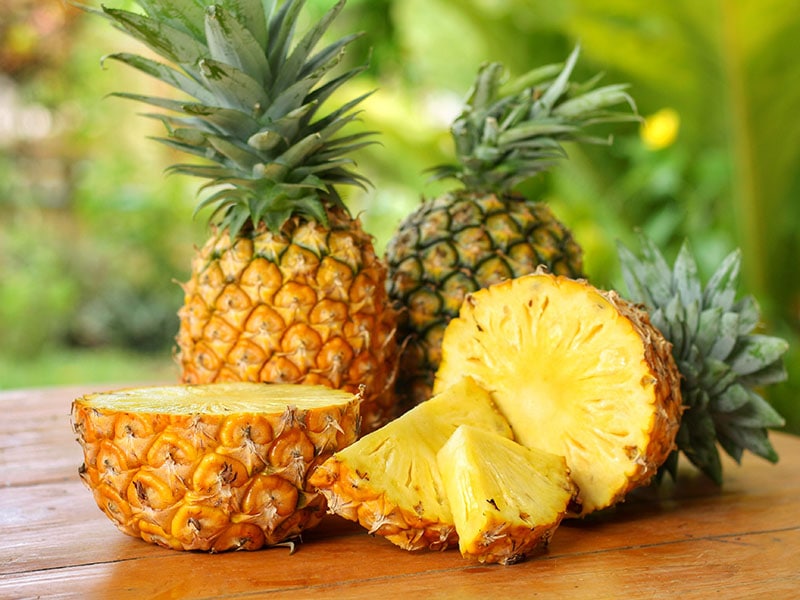
The tropical climate of Hawaii is suitable for the growth of pineapple. Indeed, this fruit is famous on this island and has become a symbol of Hawaii. Nevertheless, pineapple has its origin in South America.
In Hawaii, the pineapple industry appeared for the first time in the 1900s. And Jams Dole was the person who introduced this fruit to Lanai in 1922 and helped it become one of the most extensive pineapple plantations worldwide.
Hawaiians often call it “Hala kahiki” because of the similarity with Hala fruit. Hawaii had the most significant amount of exported pineapples globally, with about 80 percent of the whole canned pineapple worldwide in the 1960s.
Like pineapple in other regions, Hawaiian pineapple has an enchanting sweetness and a mild tartness. Moreover, the bright yellow color will grab your attention at first sight. People often use it to make smoothies, juice, desserts, or consume it as a fruit for breakfast.
Season: Its season lasts from mid-June to September in Hawaii.
Nutrient: It contains protein, fiber, vitamin C, and potassium.
How to eat: Get rid of the inedible skin with a knife and cut it into small pieces to consume.
Take a trip to a pineapple farm in Hawaii to explore this fruit more.
26. Coconut
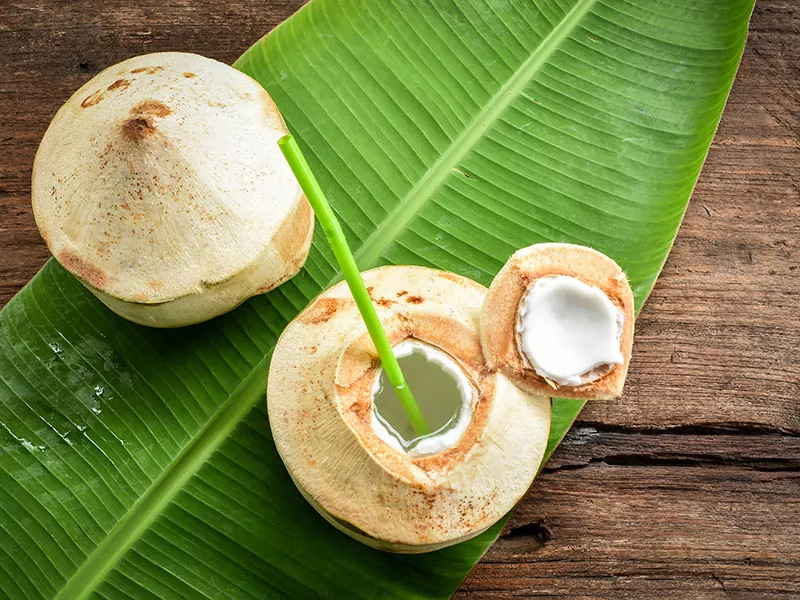
You will regret it if you do not enjoy a glass of fresh, sweet, and delicious coconut water while traveling in Hawaii. Actually, coconut is not native to this land, but they are a prominent fruit here, which was brought to the island by Polynesian voyagers decades ago.
Its name is derived from the word “coco”, which means “skull” in Portuguese. Coconut is a versatile fruit because it can do a great job in many tasty dishes, desserts, or health and beauty products.
Coconut has distinctive hard and green skin. Moreover, a thick and tough fiber layer protects the creamy flesh layer. It has a space in the middle where sweet and cool water and white flesh reside.
Hawaiians normally take advantage of the whole coconut for many purposes. The coconut husks are suitable for burning, and they use fibers for lines or ropes. Plus, the shells will be valuable in creating musical instruments.
Season: It is available all year round in Hawaii.
Nutrients: Plenty of protein, fiber, selenium, and manganese.
How to eat: Create a hole at the end of the fruit to get its water. Then you can dice it into 2 parts to enjoy the flesh.
27. Apple Banana
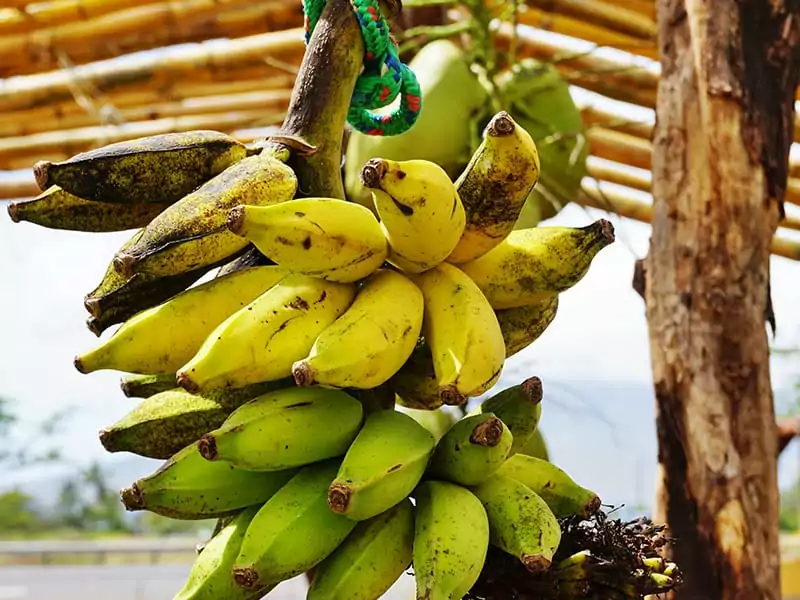
There are various cultivars of bananas, but the apple banana is the most common type on this island. This tasty fruit tastes excellent with its sweet, tangy, and rich flavor. Banana’s soft and starchy texture will leave you a good mouthfeel while eating it.
Besides Hawaii, this fruit is cultivated commonly in Southeast Asia and the Philippines. When immature, this fruit has green skin, but it will turn pink and red when ready to consume.
The small size of apple banana will be compatible for serving as a delicious and fresh snack for adults and kids. In addition, I love the creamy and silky consistency of it in smoothies, ice cream, or fruit salads.
Season: Peak season runs from June to October in Hawaii.
Nutrient: High in carbs, calories, protein, and vitamin C.
How to eat: Eat the flesh as regular bananas.
Take a trip to Hawaii to participate in harvesting apple bananas.
28. Persimmon
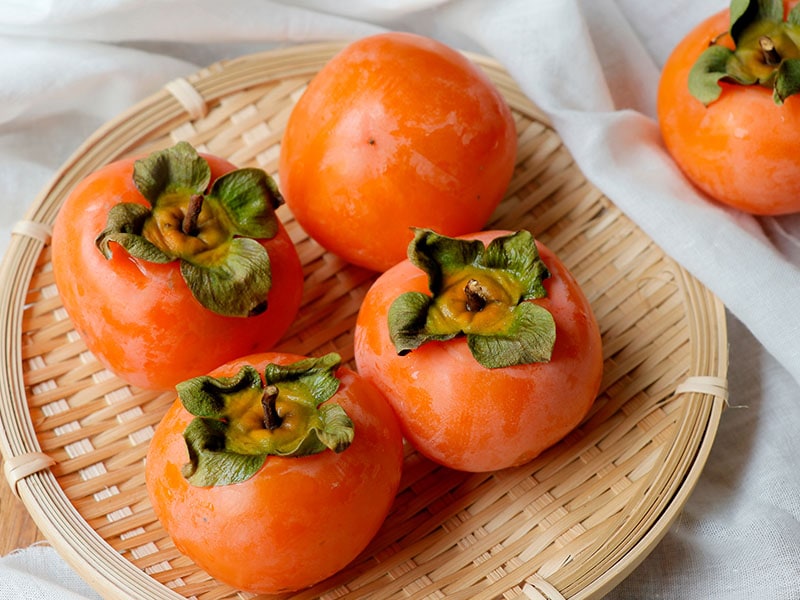
Persimmon is famous for its silky and crunchy texture. Even better, the sweet taste of this fruit knocks me down, which resembles the mix of honey, mangoes, and sweet peppers.
Its name is taken from the “pasiminan” or “putchamin” words, which means “dry fruit” in Powhatan (Algonquian language). People started calling it this English name in the 17th century.
When mature, persimmon looks outstanding in the bright yellow-orange or red-orange hues. It has astringent flesh, but the prominent flavor of the meat is sweet because it has plenty of sucrose.
You can explore numerous types of persimmon with different textures, shades, and flavors. Nevertheless, astringent and non-astringent are the 2 primary types of this incredible fruit. For production, China is the leading producer of persimmon worldwide.
Season: The season extends from October to November in Hawaii.
Nutrients: Rich in calories, carbs, fiber, vitamin E, C, and A.
How to eat: Start to peel the skin and cut it into small pieces to eat.
Let’s learn the right ways to consume persimmon at home.
Sharing Is Caring!
Have you ever tasted any fruit on this list in Hawaii? I hope you will have a chance to do that because it is a fantastic experience. It is better to remember the peak season of each fruit to enjoy these yummy fruits with the best flavor, texture, and fragrance.
Sharing the post is the most effective way to spread and introduce these amazing fruits to many other people. So, let’s do it now! If you have other concerns or opinions, please leave your comment in the below part. Thanks for reading!
